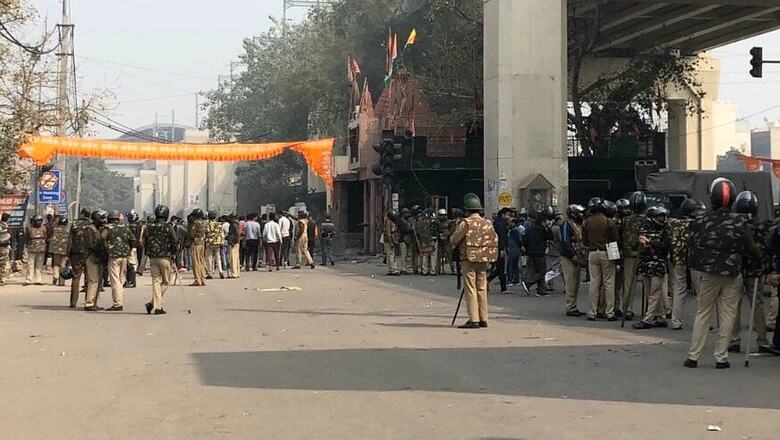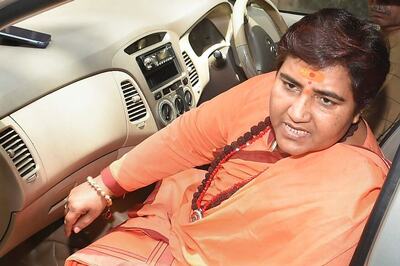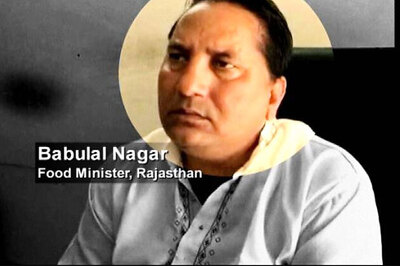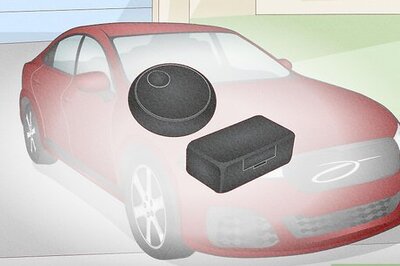
views
“I haven’t left home in the last three days. I am safe. Are you?”
Allahnu, 60, ended the phone conversation with his Hindu friend who lives about a kilometre away. He was scared, just like most residents of Jaffrabad, Maujpur, Bhajanpura, Chand Bagh and other surrounding areas of the capital city’s north-east region.
It’d been three days of living in fear of violence and death. The nearly one-kilometre stretch of road that connects Muslim-dominated Jaffrabad to Maujpur, where a majority of the residents are Hindu, was empty, dotted with shuttered shops, some of them visibly ransacked and burnt. On any other day, a visitor wouldn’t be able to tell the difference between Hindus and Muslims here. Now, the contrast was stark.
“Last time there was a Hindu-Muslim fight here was in 1992, after the Babri Masjid demolition. This feels very similar,” Allahnu said.
A night after the entire neighbourhood stayed up— both Hindus and Muslims— keeping vigil of their homes and families, the violence hadn't ended..
On Tuesday morning, hundreds of women continued sitting under the Jaffrabad metro station, their heads covered, silently reading from the paara (Quran). They had been protesting against the Citizenship Amendment Act since Saturday night. Meanwhile, in Maujpur, women sat in protest too—against the protesters. The anti-CAA demonstration site was removed by Delhi Police later in the evening.
Streets were littered with scraps of bricks; black smoke from fires had filled up the sky. Every couple of minutes, there was a cry from somewhere. Stones were hurled and, often, people emerged out of crowds with an injured, bleeding head. Throughout all of this, men and women patrolled, with sticks in their hands, threatening to beat up journalists, outsiders, and anyone who dared to shoot a photograph or a video. Outnumbered, the stick-wielding, helmet-wearing police stood on one side of the road.
Syed Suhail, who owns a shop on that stretch of road, had not dared to open the shutters. “I have never seen this kind of hatred. This used to be a peaceful neighborhood,” he said. Syed is hopeful that peace will soon arrive. “Hindu customers have been calling me to ask about my safety,” he said.
The haunting memories of 1992 engulfed the Seelampur assembly constituency, as residents said a rally by Bharatiya Janata Party’s Kapil Mishra to counter the anti-CAA protests in the area was followed by waves of stone-pelting. Mishra then posted a tweet inviting those who supported the CAA to Maujpur Chowk at 3 pm as an answer to the blockade at Jaffrabad. “Three days ultimatum to Delhi Police, Jaffrabad and Chand Bagh roads should get cleared, or don’t try to convince us, we would not even listen to you, just three days,” the tweet read. Less than two hours later, a scuffle broke out in the neighborhood that soon escalated into confrontations between Hindus and Muslims, who pelted each other with rocks, leading to injuries and deaths. The police had to fire teargas shells to bring the situation under control.
The BJP leader also tweeted a video where he was seen next to deputy commissioner of police (northeast) Ved Prakash, while issuing the warning that his supporters were only waiting till United States President Donald Trump's visit and after that they would not listen to even the Delhi Police and would ensure that all roads blocked by anti-CAA protesters were cleared.
Mishra was nowhere in sight. But, three days after his tweet, the violence continued.
“It’s just like that time in 1992 for us. After the demolition of Babri Masjid the constituency was under curfew. There were a few deaths and the police attacked us,” said Aslam Khan, who drives a rickshaw.
Khan, who has been living in Seelampur for nearly 40 years, vividly remembers the face of Iqbal, the young boy who died in his arms twenty-seven years ago. “He fell into my arms and breathed his last in my embrace. I can’t forget his death my entire life. Now, this upheaval is scratching those old wounds,” he said.
The death toll has now risen to 20. A police officer, too, was bashed in the head with a rock.
Mohammad Javed, a manufacturer, sitting with a crowd of men in Jafferbad area, kept repeating the words, “We have to maintain peace”. “If we are violent, we will lose our humanity,” he said.
Javed is a BJP party worker whose entry into politics happened back in 1997, with the Akhil Bharatiya Vidyarthi Parishad, in his college campus. He said he was glad that he didn’t invite Manoj Tiwari, city BJP president and Member of Parliament from the North-East Delhi constituency, in the neighbourhood, ahead of the Delhi elections. “My friends in the locality are taunting me for even thinking about sending an invite to Manoj Tiwari. They are telling me that I would have made a big mistake by calling him here, especially at this time.”
Javed was in class XII when the 1992 incident happened. “When the Babri Masjid was demolished, community members had gathered at this same road to condemn the demolition. The police tried to stop us, the situation turned violent and some even died.” But, Javed said, “This time it’s worse than what it was back then.”
“This is new-age politics,” he said. “Indian politicians, together, want to break the country."
The Seelampur constituency, which includes some of these neighbourhoods, recorded the highest voter turnout (71.4 per cent, as per Election Data data). “The people voted against the CAA politics, they wanted to use their voting rights to keep divisive politics out but here we are now... there is more aggression in today,s politics,” Javed said.
At Maujpur, 53-year-old Rajesh Bhasin had just returned from the hospital after getting his head injury bandaged. Bhasin, who runs a confectionery business, said that they were tired of the protests and the road blockades across Delhi—in Shaheen Bagh, Jaffrabad, and other areas—and decided to protest against them. “We were chanting Jai Shri Ram, Bharat Mata ki Jai slogans when a mob came with swords and attacked us,” he said.
Residents of both the neighbourhoods had been awake all night. “We have been guarding our homes,” said a resident of Maujpur. Meanwhile, an old woman raised a flag and shouted a slogan to "Shoot the traitors". Simultaneously, a mob from there ran towards Kabir Nagar, just across the street of Maujpur, with stones in hands. One of them returned with a bleeding forehead.
Amid the palpable anger on both sides, the fear among most residents was starkly visible. Tayaab Ansari, a native of Bihar, who lives in the Gonda Chowk area of Delhi, hasn’t gone back home in the last three days. On Sunday, he left home to get his eyes tested at Shastri Hospital in north-west Delhi. When he came back, the violence had escalated so much that, he said, there was no way he could cross the Hindu-dominated neighbourhood of Maujpur to get back home. “I need medicines, I am in pain. I need to go home,” he said. Neither Tayaab nor his family, who had been in touch with him only through phone calls, had got any sleep.
However, the situation, despite the calls from peace by politicians, had only worsened. The intermittent "maaro, maaro" combined with stone-pelting continued as anxiety and fear gripped the neighbourhood localities.
“They are forcing people to take off their pants to check…” a resident of Jaffrabad said, expressing the kind of fear the neighbourhood was dealing with. Another immediately intervened:“It may not be true. Let’s keep our peace.”
The sleepless protesters at Jaffrabad were disappointed at the media for branding them "rioters". One of them scrolled down his phone gallery to show video footage from that area. "Look, the police is with them! They helped them bring those bricks." One of the protesters then got a call from a Muslim friend who stays in the Hindu neighbourhood. “A mob has surrounded his house. How do we help him get out of there?” Another resident responded, “We can't do anything. We can't even go there. They will beat us up." Another assured, "The Hindus in the neighbourhood will save him. He is a good man.”
On Monday, several vehicles were set ablaze, and foam warehouses, shops and homes were ransacked by a crowd, which hurled petrol bombs at these establishments. The colours of some the buildings on the street were not visible anymore— they had blackened due to fire, ashes in front of them. Shattered glass from the window of a mosque, about 500 metres away from the Jaffrabad protest site, lay across the street. The Imam of the mosque said that he didn't believe those people at the pro-CAA gathering were from the neighbourhood. “We live in peace and harmony here, we are each other’s friends. They are outsiders. They cannot be from this area,” he said.
Mohammad Ayyub, too, was unable to come to terms with the fact that the entire lane that has people from both faiths, living together, was burning with mistrust and suspicion. “Hindu landlords have Muslims tenants. Hindus here hire Muslim workers as employees. We go to each other’s weddings, we share food.”
Bhasin from Maujpur, was angry about, what he called, the “tukde tukde gang” who, he said, has no understanding of the CAA. Javed, meanwhile, explained why there’s a fear of the National Register of Citizens among the Muslim community. “They must understand our fears – we have seen the situation in Assam and how some become citizens while others are sent to detention centres. Is it going to be any different? Why doesn’t the government explain to us what the difference will be?” he added.
The older residents of the Jaffrabad neighbourhood kept talking about their haunting memories of 1992. And, that they didn't want history to repeat. “How can a politician come and destroy our years of friendship?” asked Mohammad Ayyub, a tailor in the locality. “There are Hindus living in Muslim-dominated areas and there are Muslims living in Hindu-dominated areas. We want our brothers to be safe there, so we won’t attack any Hindu here. One wrong action will endanger the life of our brothers in the other localities with Hindu majority.”




















Comments
0 comment